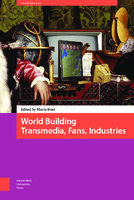World Building
Transmedia, Fans, Industries
| dc.contributor.editor | Boni, Marta | |
| dc.date.accessioned | 2019-01-30 23:55 | |
| dc.date.accessioned | 2020-03-27 15:48:21 | |
| dc.date.accessioned | 2020-04-01T10:56:15Z | |
| dc.date.available | 2020-04-01T10:56:15Z | |
| dc.date.issued | 2017-09-13 | |
| dc.identifier | 1004106 | |
| dc.identifier | OCN: 1111354422 | en_US |
| dc.identifier.uri | http://library.oapen.org/handle/20.500.12657/25975 | |
| dc.description.abstract | This edited collection of original essays situates itself at the cutting edge of media theory, exploring imaginary worlds as forms of knowledge and forms of life. By exploring the concept of worlds from theoretical and practical perspectives, this book puts forward a unique and original starting point for rethinking media theory, going beyond the notion of communication and understanding the role of worlds in interaction rituals as well as the building of values and meaning in contemporary society. In recent years, due to digital distribution and the integration of social networking and entertainment content, viewing strategies and narrative forms are undergoing important changes. Notably, we are faced with the rise of multi- platform conglomerates, in which film, television, Internet, graphic novels, toys, and virtual environments create heterogeneous yet compact universes, recognizable as brands and having a well-defined semiotic identity. Scholars are looking for new theoretical tools to understand the role of contemporary new media in these phenomena and the increasingly central place that viewers hold in exploring, mapping, interpreting and expanding story worlds. On the one hand, Internet networks are increasingly studied as the environment for the emergence of forms of consumption through fragments. As Henry Jenkins recently underlined, media become spreadable (Jenkins, Ford, Green 2013). On the other, the observation of production practices in the contemporary media sphere shows that, instead of being only fluid and ephemeral elements, media fragments sometimes converge in persistent and heterogeneous spaces built from multiple contributions and comparable to worlds. Media creators don't merely forge stories or characters. Instead, they build worlds: fictional worlds, character worlds, alternative worlds... | |
| dc.language | English | |
| dc.relation.ispartofseries | Transmedia | |
| dc.subject.classification | thema EDItEUR::A The Arts::AT Performing arts::ATF Films, cinema::ATFA Film history, theory or criticism | en_US |
| dc.subject.other | Media & Communications | |
| dc.title | World Building | |
| dc.title.alternative | Transmedia, Fans, Industries | |
| dc.type | book | |
| oapen.identifier.doi | 10.2307/j.ctt1zkjz0m | |
| oapen.relation.isPublishedBy | dd3d1a33-0ac2-4cfe-a101-355ae1bd857a | |
| oapen.relation.isFundedBy | b818ba9d-2dd9-4fd7-a364-7f305aef7ee9 | |
| oapen.relation.isbn | 9789089647566 | |
| oapen.collection | Knowledge Unlatched (KU) | |
| oapen.place.publication | Amsterdam | |
| oapen.grant.number | 102577 | |
| oapen.grant.program | KU Select 2018: HSS Backlist Books | |
| oapen.identifier.isbn | 9789089647566 | |
| grantor.number | 102577 | |
| oapen.identifier.ocn | 1111354422 |

